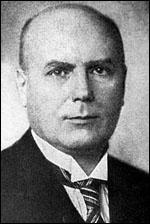Ernst Bergmann

Ernst Bergmann was born in Colditz, Germany, on 7th August 1881. He studied philosophy at the University of Leipzig and got his PhD in 1905. After further studies in Berlin he returned to Leipzig where he became Ausserordentlicher Professor. (1)
Bergmann held right-wing nationalist views and became a supporter of Adolf Hitler and in 1930 he joined the Nazi Party. He published several books including Knowledge and Mother Spirit (1932), The German National Church (1933), A National Socialist Philosophy of Culture (1933) and The German Religion (1934). (2)
In July 1933, Pastor Ludwig Müller, a long-term supporter of Hitler was elected as Reich Bishop. (3) His work was supported by Professor Bergmann, who in 1934 issued the Twenty-Five Points of the German Religion. This included the following: (i) The Jewish Old Testament as well as parts of the New Testament are not suitable for the new Germany. (ii) Christ was not Jewish but a Nordic martyr put to death by the Jews, a warrior whose death rescued the world from Jewish influence. (iii) Adolf Hitler is the new Messiah sent to earth to save the world from the Jews. (iv) The swastika succeeds the cross as the symbol of German Christianity. (v) German land, German blood, German soul, German art - these are the sacred assets of German Christians. (4)
Susan Ottaway has argued that many Protestants saw Bergmann's theories as "utter drivel". She points out: "The second point alone high-lights the inconsistency of the doctrine. If Christ's death rescued the world from Jewish influence, why did the Nazis find it necessary to persecute them? The entire document was complete nonsense and utterly at odds with any conventional view of Christianity. In spite of this it had its supporters, who became known as German Christians." (5)
The German Christians became a pressure group and movement within German Protestantism. Bergmann became the most important academic involved in the movement. The German Christians ardently supported the Nazi doctrines of race and the leadership principle. By the time Hitler came to power, the movement had some three thousand out of a total of seventeen thousand pastors, though their lay followers probably represented a larger percentage of churchgoers. (6)
The movement was popular with young pastors from lower-middle-class backgrounds or non-academic families. "Such men desired a Church whose members were soldiers from Jesus and the Fatherland, tough, hard and uncompromising. Muscular Christianity of this kind appealed particularly to young men who despised the feminization of religion through the involvement in charity, welfare and acts of compassion." (7)
Ernst Bergmann committed suicide in Leipzig on 16th April, 1945.
Primary Sources
(1) Ernst Bergmann, Twenty-Five Points of the German Religion (1934)
(i) The Jewish Old Testament as well as parts of the New Testament are not suitable for the new Germany.
(ii) Christ was not Jewish but a Nordic martyr put to death by the Jews, a warrior whose death rescued the world from Jewish influence.
(iii) Adolf Hitler is the new Messiah sent to earth to save the world from the Jews.
(iv) The swastika succeeds the cross as the symbol of German Christianity.
(v) German land, German blood, German soul, German art - these are the sacred assets of German Christians.
Student Activities
Kristallnacht (Answer Commentary)
Adolf Hitler's Early Life (Answer Commentary)
Heinrich Himmler and the SS (Answer Commentary)
Trade Unions in Nazi Germany (Answer Commentary)
Adolf Hitler v John Heartfield (Answer Commentary)
Hitler's Volkswagen (The People's Car) (Answer Commentary)
Women in Nazi Germany (Answer Commentary)
German League of Girls (Answer Commentary)
